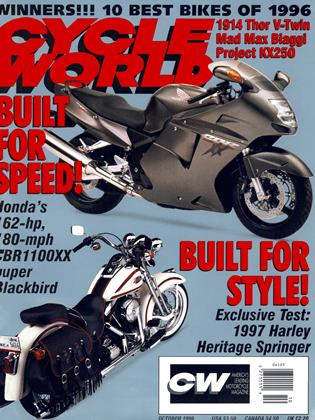QUICK RIDE
ROUNDUP
SUZUKI RGV250SP Grand Prix racer for the street
RACE REPLICAS, PARTICUlarly those patterned after two-stroke grand prix machines, aren’t as popular as they used to be. In the late 1980s, all four Japanese manufacturers had 250cc sporting strokers in their lineups and upgraded them constantly. But prior to last fall’s Tokyo Motor Show, there hadn’t been any developments in a long, long time.
That changed with the introduction of the all-new Suzuki RGV250SP, the first upgrade to the RG250 Gamma in eight years. Patterned after the XR95 factory roadracer that won last year’s All-Japan 250 Championship, the ’96 SP (for “Sports Production”) features the same body style, engine configuration and chassis geometry as the racebike.
The engine is a 249cc, liquidcooled, crankcase-reed-valveinducted, 70-degree V-Twin that’s 1.5 inches shorter than the previous model’s. The racebike’s dry clutch and cassettestyle, six-speed transmission are retained, while a vibrationreducing counterbalancer allows the engine to be used as a stressed member in the twinspar aluminum chassis. A diminutive electric starter measuring less than 2 inches in diameter and weighing just 1.5 pounds gets the fires lit.
Other high-tech features include a computer-controlled ignition, automatic oil injection, self-adjusting exhaust powervalves, ram-air induction and dual Mikuni 32mm carburetors with electronic solenoids varying the air mixture. The inverted fork and single piggyback-reservoir shock are both fully adjustable, while the 17inch wheels are fitted with specially designed Dunlop radiais. Triple-disc brakes provide all the stopping power you could ever need.
Suzuki recently hosted a press introduction for the RGV at its Ryuyo proving grounds in Japan. The riding position is tight and purposeful, as you’d expect from a 250cc GP bike, but not so uncompromising that it hinders street riding. (An R&D spokesperson explained that they wanted the RGV to be as versatile as a pair of sneakers.)
Acceleration isn’t as impressive as it could be, because the factory purposely limited engine output to 40 horsepower (an available race kit is claimed to double this figure). Though peak power comes at 9500 rpm, the engine can be overrevved to 12,500, good for an indicated 120 mph on the test track’s main straight.
Handling is natural and easy, much like Yamaha’s TZR250, though less nervous. High-speed stability is impressive-especially considering the RGV’s short, 52.4-inch wheelbase coupled with a racy 24 degrees of rake and 3.5 inches of trail-but the 295pound flyweight is most at home on tight canyon roads.
Nimble, quick, confidenceinspiring and-at $7500 in Japan-relatively inexpensive, the RGV250SP is a GP fan’s dream. Pity that emissions laws keep two-stroke streetbikes from being sold in the U.S.
-Yasushi Ichikawa
 View Full Issue
View Full Issue












